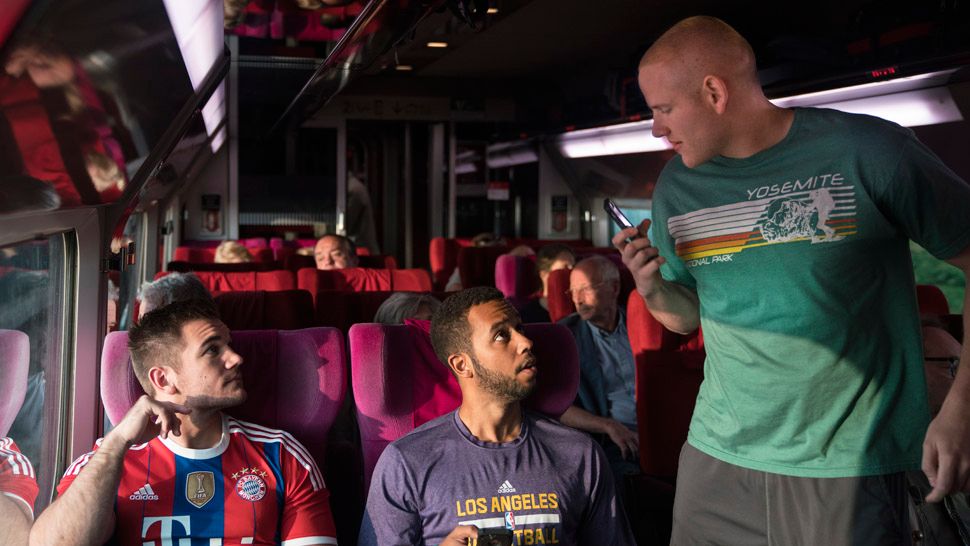While it is built around an incredible story of courage and nerve that director Clint Eastwood masterfully recreates on film, “The 15:17 to Paris” is a mixed bag as a feature film.
The film makes a deliberate effort to provide as much context as possible for why the three Americans on that train from Amsterdam to Paris on August 21, 2015 took the actions they did, and the skills and lessons they learned both as kids and adults that helped them save all those lives that day.
All that context turns out to be too much of a good thing, as it results in a film that feels both unfocused and heavy-handed.
What’s it about?
The real-life story has been well documented. On that day a single gunman, Ayoub El Khazzani, boarded Thalys train 9364 in Amsterdam and while it was in French territory emerged from one of the train’s restrooms with an assault rifle and more than 300 rounds of ammunition.
El Khazzani shot one passenger but was subdued before he could harm anyone else by three Americans – U.S. Airman Spencer Stone, U.S. Army Specialist Alek Skarlatos, and Anthony Sadler. Stone then utilized his medical training to keep the wounded passenger alive until the train arrived in Arras and secured by local authorities.
“The 15:17 to Paris” not only recreates the events on the train, but also shares the story of the three Americans, childhood friends whose presence on the train, the film asserts, almost felt like divine providence both before and after the crisis they helped avert.
Casting the real-life people
Eastwood challenges himself as a filmmaker in this particular outing by casting the real-life heroes who were on the train that day – Stone, Skarlatos, and Sadler – as themselves and featuring them for most of the film. Others who were on the train that day, including Mark Moogalian, the man shot by El Khazzani, also play themselves in the scenes set during the attack.
Give Eastwood credit. When it comes to the actual struggle on the train, the casting, along with Eastwood’s staging and camera direction, creates an intense, visceral viewing experience. He places audiences right in the middle of those terrifying moments, and effectively captures both the fear in the passengers as well as the poise the men who intervened that day.
However, when it comes to depicting everything leading up to those moments, the casting gambit falls short. One might think playing themselves would come naturally, especially living out moments they experienced, but Stone, Skarlatos and Sadler all come off sounding wooden rather than authentic.
They look and sound like they’re reciting lines they memorized, which, of course, is exactly what they did for the film.
Film structure dilutes impact
“The 15:17 to Paris” also suffers from imbalance in terms of structure. It takes too much time to get down to what audiences bought tickets to see – Eastwood’s depiction of the attack and how it was stopped – and gets bogged down in methodically establishing context and a reasoning for why Stone, Skarlatos and Sandler were there to help that day.
The flawed approach may have come, in part, from the source material. Screenwriter Dorothy Blyskal based her screenplay on the autobiography the three men wrote along with writer Jeffrey Stern, which chronicled not only the event, but their friendship from childhood and events that foreshadowed the roles they would play that fateful day.
The film takes that same approach, ostensibly to honor the heroes’ stories in their entirety, but what results on screen feels scattered and labored. Much of the film’s middle portion, which focuses on the men backpacking through Europe in the days prior to the attack, feel especially superfluous, venturing into travelogue territory.
Worth seeing?
Even with its flaws, “The 15:17 to Paris” can still be held up as a well-meaning tribute to real-life American courage in the face of potential tragedy.
Like Eastwood’s previous film effort, “Sully,” it highlights an unforgettable display of poise and purpose in terms of what the real people did. The director clearly had the best of intentions in terms of bringing these stories to life for audiences to see and reflect upon.
However, this one just doesn’t work as well. The risks taken and the methodical approach to the material simply do not pay off, resulting in a rare film from Eastwood that lacks punch.
The 15:17 to Paris
Starring Spencer Stone, Alek Skarlatos, Anthony Sadler, Judy Greer, Jenna Fischer, P.J. Byrne, Tony Hale and Thomas Lennon. Directed by Clint Eastwood.
Running time: 95 minutes
Rated PG-13 for bloody images, violence, some suggestive material, drug references and language.



